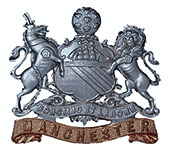C A M E O O F T H E M O N T H
Each month I will put on the website the story of a soldier who died during the First World War.
They are selected at random.
Each month I will put on the website the story of a soldier who died during the First World War.
They are selected at random.
Thiepval Memorial
40249 Private Alfred Smith
20th Battalion Manchester Regiment
Died on Friday 22nd December 1916, aged 16
Commemorated on Pier and Face 14 C.
Died on Friday 22nd December 1916, aged 16
Commemorated on Pier and Face 14 C.

Alfred was born at home, son of James Henry and Isabella Smith, of 31 Rockcliffe Street, Blackburn. He had elder siblings, Thomas, Elizabeth Ann, James Henry, Charles Edward, Joseph, John and William with younger sisters, Lily and Isabella.
He volunteered and enlisted in Blackpool, Lancashire. After training Alfred left for France with a draft. The Battalion was in the Ploegsteert sector when a draft joined the Battalion in Papot on Thursday 26th October 1916. The next day they went into the front line to relieve the 2nd Warwickshires. During Saturday 28th 2 men were killed, 2 wounded including 2nd Lieutenant Theodore Wright Crewdson, promoted to Captain, who died on Monday 6th November and is buried in Boulogne Eastern Cemetery, VII.B.9. The tour of duty ended at 2.00pm on Tuesday 31st October when they went in Support, ‘A’ in ‘Gloster House’, ‘B’ in ‘Plugsteet Hall’, ‘C’ in ‘Hunters Avenue North’ and ‘D’ in ‘Hunters Avenue South’. After 36 hours they were relieved to billets in ‘Creslow Farm’ for just over 2 days. The Battalion marched to l’Estrade for a week, then moved to Houlle where 10 Officers reported for duty. Training ended on Wednesday 15th November when a series of moves eventually took them to Bertrancourt arriving on Thursday 23rd. Training continued together with fatigues.
The Battalion returned to the front on Wednesday 29th to relieve the 1st South Staffs in ‘Beaumont Hamel Defences’. Fatigues were undertaken from Thursday 30th collecting salvage, carrying trench boards to ‘Leave Avenue’ and clearing out a German dugout to make a gum boot store. The relatively quiet tour of duty ended on Monday 11th December when they proceeded to hutments in Acheux Wood. The next day baths were made available in Bertrancourt and Mailly. Fatigues and training began from Wednesday 13th. Their main work was on the improvements to the roads in the area.
At 6.00pm on Sunday 17th the Battalion relieved the 2nd Gordons where there was considerable artillery activity. 2nd Lieutenant Charles Stephen Fuller reported for duty on Tuesday 19th, he later transferred to the RFC, awarded the MC, dying on Sunday 11th November 1917 and is buried in Bailleul Communal Cemetery Extension, Nord, II.E.64. The German artillery targeted ‘Station Road’ and ‘Beaucourt Trench’ over the ensuing days. The shelling on Friday 22nd killed Privates Sidney Holmes and 16 year-old Alfred Smith, both are commemorated on the Memorial.
He volunteered and enlisted in Blackpool, Lancashire. After training Alfred left for France with a draft. The Battalion was in the Ploegsteert sector when a draft joined the Battalion in Papot on Thursday 26th October 1916. The next day they went into the front line to relieve the 2nd Warwickshires. During Saturday 28th 2 men were killed, 2 wounded including 2nd Lieutenant Theodore Wright Crewdson, promoted to Captain, who died on Monday 6th November and is buried in Boulogne Eastern Cemetery, VII.B.9. The tour of duty ended at 2.00pm on Tuesday 31st October when they went in Support, ‘A’ in ‘Gloster House’, ‘B’ in ‘Plugsteet Hall’, ‘C’ in ‘Hunters Avenue North’ and ‘D’ in ‘Hunters Avenue South’. After 36 hours they were relieved to billets in ‘Creslow Farm’ for just over 2 days. The Battalion marched to l’Estrade for a week, then moved to Houlle where 10 Officers reported for duty. Training ended on Wednesday 15th November when a series of moves eventually took them to Bertrancourt arriving on Thursday 23rd. Training continued together with fatigues.
The Battalion returned to the front on Wednesday 29th to relieve the 1st South Staffs in ‘Beaumont Hamel Defences’. Fatigues were undertaken from Thursday 30th collecting salvage, carrying trench boards to ‘Leave Avenue’ and clearing out a German dugout to make a gum boot store. The relatively quiet tour of duty ended on Monday 11th December when they proceeded to hutments in Acheux Wood. The next day baths were made available in Bertrancourt and Mailly. Fatigues and training began from Wednesday 13th. Their main work was on the improvements to the roads in the area.
At 6.00pm on Sunday 17th the Battalion relieved the 2nd Gordons where there was considerable artillery activity. 2nd Lieutenant Charles Stephen Fuller reported for duty on Tuesday 19th, he later transferred to the RFC, awarded the MC, dying on Sunday 11th November 1917 and is buried in Bailleul Communal Cemetery Extension, Nord, II.E.64. The German artillery targeted ‘Station Road’ and ‘Beaucourt Trench’ over the ensuing days. The shelling on Friday 22nd killed Privates Sidney Holmes and 16 year-old Alfred Smith, both are commemorated on the Memorial.
